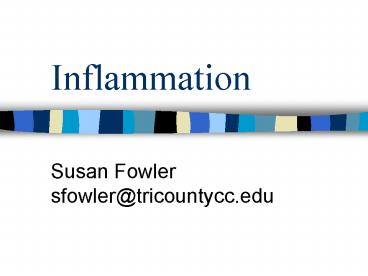Inflammation PowerPoint PPT Presentation
1 / 23
Title: Inflammation
1
Inflammation
- Susan Fowler sfowler_at_tricountycc.edu
2
Objectives p. 4
- Inflammation and Infection objectives are
intertwined. - Inflammation is the concept and appendicitis is
the exemplar (best example) of inflammation.
3
Inflammation What it is and What it isnt.
- The bodys cellular response to injury,
infection, or irritation. - Mechanism is the same regardless of injuring
agent. - Always present with infection.
- It is not infection. Infection is not always
present with inflammation.
4
Inflammatory Response
- Intensity depends on extent and severity of
injury bodys ability to react - Sequential
- Neutralizes dilutes inflammatory agent
- Removes necrotic materials
- Establishes an environment suitable for healing
and repair
5
Causes of Inflammatory Response
- Heatburn injury
- Radiationsunburn, radiation tx
- Trauma
- Allergenssinuses anaphylactic shock
- Infection
6
Steps of Inflammatory Response
- Vascular response
- Cellular response
- Formation of exudate
- Healing
7
Vascular Response
- Cell injury
- ?local vasoconstriction
- ?release of kinins, antihistamines,
prostaglandins - ?local vasodilation and hyperemia
- ?increased capillary pressure and permeability
- ?fluid exudate from capillaries to tissue spaces
leading to edema
8
Vascular Response contd
- Fluid exudate contains fibrinogen
- Fibrinogen changes to fibrin
- Fibrin and platelets make clot
- Clot traps bacteria to prevent spread
9
Cellular Response
- WBCsspecifically neutrophils and
monocytesmigrate thru capillary walls to site of
injury. This migration is called chemotaxis. - Neutrophils and monocytes (which change to
macrophages) perform phagocytosis, cleaning up
bacteria and dead cells.
10
Cellular Response contd
- Other cells that may be released
- Eosinophilsallergic responses
- Lymphocyteshelp develop immunity
- Basophilscarry histamine and heparin
11
Cellular Response Chemical Mediators
- Mediators released that play a role in
inflammatory response and cell lysis - Histamine
- Serotonin
- Complement system
- Prostaglandins
- Serotonin
- Kinins
12
Formation of Exudate
- Formed when fluid leaks from capillaries into
tissue spaces - Made up of serous fluid, cells, chemical
mediators - Sometimes confused with infection in an open
wound because it may look milky white, yellowish,
or pale green, but it has no odor if infection is
not present.
13
Manifestations of Inflammation
- Localized response (redness, pain, swelling, etc)
and systemic response (increased TPR, malaise,
nausea, anorexia, etc) are the same as in the
infectious process (see Infection Concept
Lecture) - With a high degree of inflammation, and when
infection is present, WBCs rise
14
Types of Inflammation
- Acutehealing occurs 2-3 weeks primarily
neutrophils involved - Subacutehealing occurs same way, but takes
longer - Chronicmay last for years injurious agent
persists or repeats injury to site primarily
lymphocytes and macrophages (monocytes) involved.
15
Healing Process
- Regenerationreplacement of lost cells and
tissues with cells of same type - Repairreplacement of lost cells with connective
tissue (scar)
16
Healing Process contd
- Regenerative cells
- Skin
- Bone and bone marrow
- Mucous membranes
- Spleen
- Liver
- Kidney
- Pancreas
17
Healing Process contd
- Non-regenerative cells
- Neuronsreplaced by glial cells, new neurons may
be produced by stem cells - Skeletal and cardiacrepaired with scar tissue
18
Appendicitis
- Inflammation and infection of appendix located
immediately past the ileocecal valve on the side
of the ascending colon. - Causes kinking, fecalith, tumor, or foreign
body with pus formation
19
Plan of CareAssessment
- Periumbilical pain moving to McBurneys point
- Rovsings, Blumbergs, Obturator, Ileopsoas
- Guarding
- Pain with DRE
- Low grade fever
- Anorexia
- NVD or constipation
- Elevated WBC, abd x-ray
20
Plan of Care Expected Outcomes
- Patient will receive proper management of
appendicitis - Patients pain will be controlled
- Infectious and inflammatory processes will
subside - Patient will experience full recovery without
complications (wound infection, DVT, respiratory
infection, etc.) - Patient will receive and understand all
instructions
21
Plan of Care Interventions
- Appendectomy
- -Open or laparoscopic
- -Usually 24h stay but if perforated, several
days with NG, IV, drains, possible open wound, IV
meds - -Pre and postop antibiotics
22
Plan of Care Nursing Mgmt
- Depends on whether OP or inpatient
- Preoperatively, pt is assessed, site is marked,
laxatives enemas are contraindicated - Postop VS per protocol
- Pain controlIV to po
- IVF and meds
- Wound assessment and changes (if inpatient)
- Advance DAT and activity
- Pt education re wound care, SS infection, pain
mgmt, activity restrictions, RTC time, when to
call MD.
23
Plan of Care Evaluation
- Appendicitis has been resolved
- Appendectomy performed successfully
- Infection and inflammation has subsided as
evidenced by VS and WBC returned to normal levels - Patients pain is controlled
- Patient had no complications
- Patient received and understood all instructions

